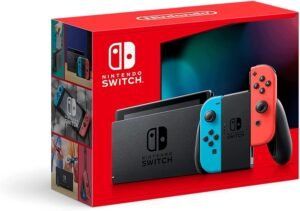The Buzz Around Nintendo Switch 2: Release Date Rumors, Features & Expectations
The Nintendo Switch 2 is one of the most anticipated gaming consoles in recent years, sparking excitement across gaming forums, news sites, and social media. Ever since the original Nintendo Switch launched in 2017, blending handheld and home console gaming in a revolutionary way, fans have been eager for a more powerful upgrade. Now, all eyes are on the Nintendo Switch 2 release date, features, and game compatibility—topics that dominate gamer search trends worldwide.
Nintendo Switch 2 Features Gamers Want Most
1. Next-Level Graphics and Performance
One of the hottest topics is the graphics upgrade on Nintendo Switch 2. With new processing power, the Switch 2 could deliver smoother animations, higher frame rates, and detailed environments rivaling PS5 and Xbox Series X titles. This leap in performance could transform franchises like Zelda, Mario, and Pokémon, making them even more immersive.
2. Improved Battery Life for Handheld Play
A major criticism of the first Switch was its limited battery life. The Switch 2 battery upgrade is expected to solve this issue, allowing longer gaming sessions without frequent charging. For gamers on the go, this improvement will be game-changing.
3. Backward Compatibility with Original Switch Games
Backward compatibility is a top-requested feature. If Nintendo allows players to use their existing Switch game library on the new console, it will create a seamless transition while rewarding loyal fans who have already invested in the ecosystem.
 Get Your Nintendo Switch 2
Get Your Nintendo Switch 2
Meta Quest 3: Why It’s a Game-Changer for VR
Alongside the Nintendo Switch 2, another major hardware launch in gaming is the Meta Quest 3 VR headset. Designed to push the boundaries of virtual reality, the Quest 3 is packed with features that make it one of the most searched gaming devices of the year.
Enhanced Display and Realism
The Meta Quest 3 display upgrade brings higher resolution, improved refresh rates, and vibrant visuals. This not only reduces VR motion sickness but also makes virtual worlds more lifelike than ever.
Ergonomics and Comfort
With a lighter design and improved comfort, Quest 3 aims for longer VR play sessions. Intuitive controls and better haptics are expected to increase user satisfaction, making VR more mainstream-friendly.
How Nintendo Switch 2 and Meta Quest 3 Will Influence Gaming Content
Both consoles are set to reshape the gaming industry. Developers will take advantage of the Switch 2’s hardware to build expansive open worlds, while Quest 3 opens doors for new VR game genres, social interaction, and immersive storytelling.
-
Switch 2 impact: Expect enhanced AAA titles, better indie performance, and more detailed environments.
-
Quest 3 impact: Look for VR-exclusive experiences and social games that redefine multiplayer interaction.
Shifting Search Trends: What Gamers Are Searching For
Recent search data shows gamers are increasingly looking for:
-
“Nintendo Switch 2 release date and specs”
-
“Meta Quest 3 VR price and features”
-
“Crossplay games on next-gen consoles”
-
“Exclusive Switch 2 titles”
Cross-platform gaming, VR innovation, and exclusive titles are all influencing consumer behavior. With streaming and content creation booming, both the Switch 2 and Quest 3 will likely integrate features for easy game capture, Twitch streaming, and social sharing.
Final Thoughts
The Nintendo Switch 2 and Meta Quest 3 aren’t just upgrades—they represent the future of console and VR gaming. With better performance, immersive experiences, and consumer-driven features, they’re shaping what players expect from modern gaming.
👉 For fans, the real question isn’t if these devices will change the gaming landscape, but how soon they’ll get their hands on them.
